Samsung Electronics Bundle
How Does Samsung Dominate the Tech World?
From humble beginnings to global dominance, Samsung Electronics has masterfully navigated the cutthroat consumer electronics and semiconductor industries. Witness the evolution of a company that transformed from a budget-friendly brand to a powerhouse of innovation, particularly with the groundbreaking success of its Galaxy smartphone series. Discover the secrets behind Samsung's remarkable journey and its unwavering commitment to technological advancement.
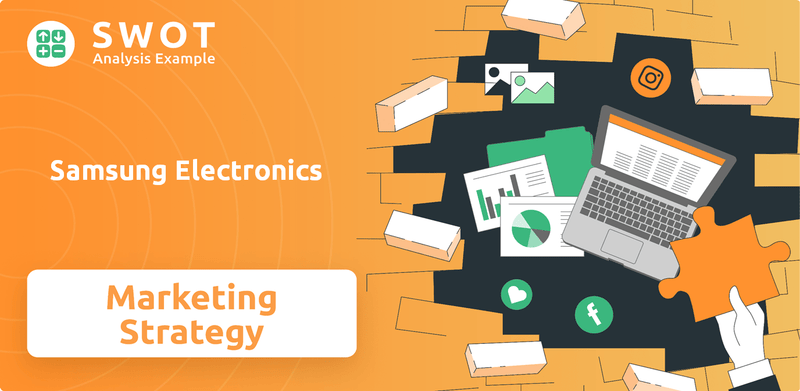
This article unlocks the intricacies of Samsung Electronics SWOT Analysis, examining its dynamic sales and marketing strategies that have propelled it to the forefront. We'll explore how Samsung's strategic blueprint, including its sophisticated marketing tactics and innovative product launches, has allowed it to maintain a leading Samsung market share. Dive into the details of Samsung's digital marketing strategy, social media marketing campaigns, and competitive analysis to understand how this tech giant consistently outmaneuvers its rivals. Explore Samsung's sales and marketing tactics, brand positioning, and how it allocates its marketing budget to achieve impressive sales performance and marketing ROI.
How Does Samsung Electronics Reach Its Customers?
The sales strategy of Samsung Electronics Company revolves around a comprehensive omnichannel approach, blending both online and offline channels to reach a wide customer base. This strategy is designed to maximize its market presence and cater to diverse consumer preferences. The company leverages its own e-commerce platforms alongside partnerships with major retailers and a robust physical retail network.
Samsung's sales channels are strategically designed to ensure product availability and enhance customer experience. This includes direct sales through its official website, collaborations with online retailers, and a strong physical retail presence through dedicated stores and experience centers. The company also utilizes a multi-tiered distribution system, ensuring products reach consumers through various channels.
The evolution of Samsung's sales channels reflects a strategic shift towards direct-to-consumer (DTC) sales while maintaining strong third-party partnerships. Recent developments, such as joint ventures and acquisitions, are aimed at strengthening its market position and expanding its distribution networks, particularly in key sectors like HVAC systems.
Samsung's e-commerce strategy includes its official website for direct sales, offering exclusive deals, and partnerships with major online retailers like Amazon and Best Buy. Samsung's B2B online sales doubled as of February 2023 compared to the previous year, indicating a strong focus on digital channels. This approach enhances its Samsung sales strategy and expands its digital footprint.
Samsung maintains a significant physical retail presence through dedicated stores and experience centers, offering hands-on product experiences. Collaborations with major electronics retailers, local stores, and hypermarkets ensure broader distribution. This strategy supports Samsung electronics marketing by providing direct customer interaction and showcasing products effectively.
Samsung's distribution network involves a multi-tiered system with authorized distributors and retailers, ensuring product availability. Goods flow from manufacturing units in places like Noida and Chennai, India, through national distributors and state-level C&F agents. This extensive network is crucial for Samsung's distribution channels and reaching a global audience.
Samsung forms key partnerships with telecom providers to offer bundled deals, enhancing sales and customer value. A 2024 joint venture with Lennox International granted access to a broad U.S. distribution network for HVAC systems. In November 2024, Samsung Electronics Philippines Corp. (SEPCO) partnered with Versatech International as an official distributor for mobile devices in the Philippines. These partnerships support the Samsung marketing strategy.
Samsung employs various tactics to boost sales and enhance its market presence. These include a strong emphasis on direct-to-consumer (DTC) sales, strategic partnerships with telecom providers, and expansion of its B2B online presence. The company is also focused on expanding its distribution networks through acquisitions and joint ventures, such as the acquisition of FläktGroup, expected to close by the end of 2025, to strengthen its position in the U.S. commercial and industrial HVAC market.
- Direct-to-consumer (DTC) sales through official website and stores.
- Partnerships with major online and offline retailers.
- Bundled deals with telecom providers.
- Expansion of B2B online presence.
- Strategic acquisitions and joint ventures.
Samsung Electronics SWOT Analysis
- Complete SWOT Breakdown
- Fully Customizable
- Editable in Excel & Word
- Professional Formatting
- Investor-Ready Format
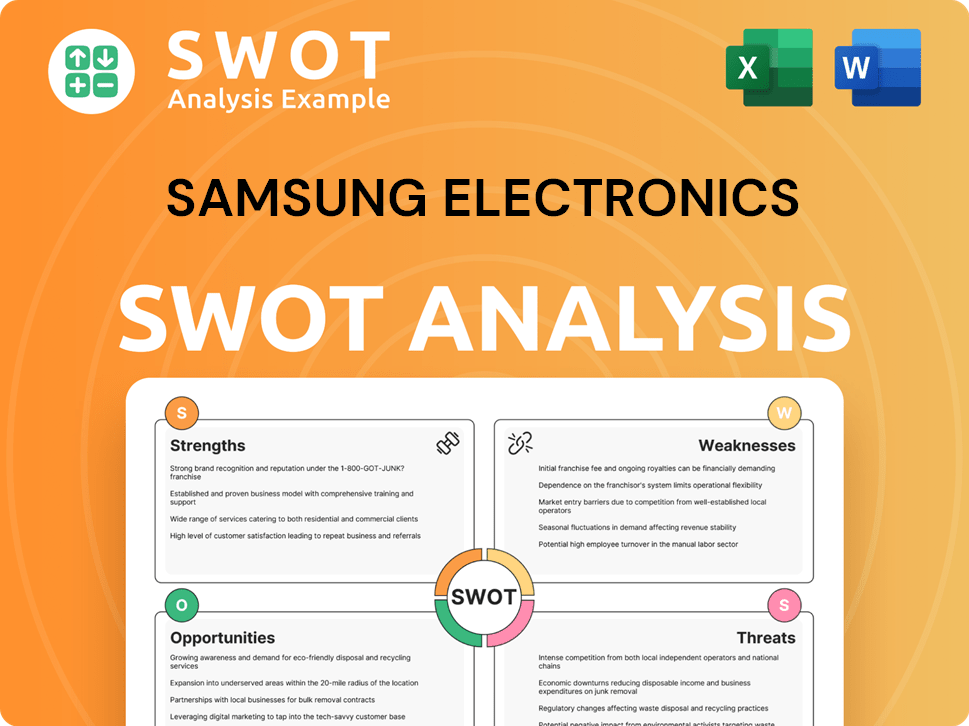
What Marketing Tactics Does Samsung Electronics Use?
The company employs a multifaceted marketing strategy, blending digital and traditional methods to enhance brand visibility, generate leads, and boost sales. This approach includes active engagement on social media platforms, targeted email campaigns, and strategic partnerships with influencers. The company's marketing efforts are designed to boost global and regional brand awareness and promote innovation, driving its Samsung sales strategy.
Traditional media continues to play a significant role, with high-budget TV commercials, print ads, and outdoor billboards. Events and sponsorships, such as showcasing innovations at tech expos and sponsoring major events, are also crucial for brand visibility and aligning the brand with excellence and innovation. This comprehensive approach supports the company's Samsung marketing strategy.
The company's marketing approach is deeply rooted in data analytics, using customer insights to personalize and optimize campaigns. This data-driven strategy allows for more effective targeting and improved customer experiences, which leads to increased conversions and revenue. This data-driven approach is crucial for the company's Samsung electronics marketing success.
The company leverages various digital platforms to connect with consumers. This includes active engagement on social media, targeted email marketing, and search engine marketing (SEM) to increase visibility. These strategies support the company's Samsung's digital marketing strategy.
The company uses social media platforms like X/Twitter, Instagram, Facebook, and TikTok for engaging content and interactive campaigns. They encourage user-generated content and collaborate with influencers. These efforts are part of Samsung's social media marketing campaigns.
Collaborations with tech influencers, lifestyle bloggers, and celebrities are a key component of the marketing strategy. Partnerships with figures like BTS and Lionel Messi help reach diverse audiences and enhance credibility. These collaborations play a crucial role in the company's Samsung sales and marketing tactics.
Traditional media, including TV commercials, print ads, and outdoor billboards, remains a part of the marketing mix. These high-budget campaigns contribute to a strong brand presence. This approach supports the company's Samsung's advertising campaigns analysis.
Showcasing innovations at tech expos and sponsoring major events like the Olympic Games are pivotal. These activities boost visibility and align the brand with innovation and excellence. These events are part of the company's Samsung's global marketing strategy.
The company utilizes analytics to understand customer preferences and behaviors. Real-time customer data platforms, such as Adobe Real-Time CDP, are used to personalize campaigns. This data-driven approach is essential for Samsung's customer relationship management.
In 2023, the company spent $9.27 billion on marketing and advertising, allocating $3.99 billion to advertising and $5.28 billion to sales promotions, representing 4.6% of its global revenue. Innovations like AI-driven advertising tools have been implemented to boost campaign performance. For instance, during the 2024 Black Friday period, ROAS more than doubled. Furthermore, understanding the market and predicting consumer preferences is a priority, with a strong focus on research and development to introduce new products that match changing market trends. For more insights, explore the Growth Strategy of Samsung Electronics.
The company's marketing efforts focus on a blend of digital and traditional strategies to reach a broad audience. The tactics include active social media engagement, targeted advertising, and strategic partnerships.
- Digital Marketing: Active on social media platforms, targeted email marketing, and SEM.
- Influencer Marketing: Collaborations with tech influencers and celebrities.
- Traditional Media: TV commercials, print ads, and outdoor billboards.
- Events and Sponsorships: Showcasing innovations at tech expos and sponsoring major events.
- Data-Driven Approach: Utilizing analytics to understand customer behavior and preferences.
- Budget Allocation: Significant investment in advertising and sales promotions.
Samsung Electronics PESTLE Analysis
- Covers All 6 PESTLE Categories
- No Research Needed – Save Hours of Work
- Built by Experts, Trusted by Consultants
- Instant Download, Ready to Use
- 100% Editable, Fully Customizable
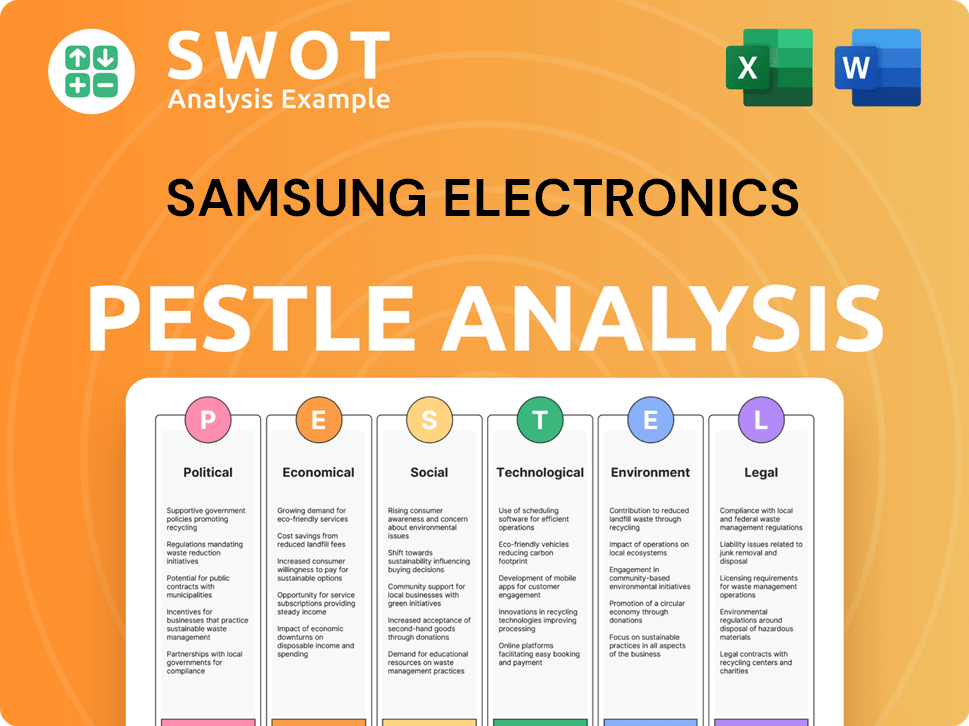
How Is Samsung Electronics Positioned in the Market?
The brand positioning of Samsung is deeply rooted in innovation and technological advancement, serving as a primary differentiator in the competitive electronics market. This focus allows the company to consistently launch devices with cutting-edge features, aiming to broaden functionality and appeal to a diverse consumer base. Samsung's strategy blends technology with lifestyle, making its products an integral part of everyday life for many.
Samsung positions itself as an innovative and trustworthy company dedicated to enhancing customers' lives through technology. This is achieved by creating an integrated ecosystem that improves user experience and builds brand loyalty. The core message revolves around enabling human potential, as seen in campaigns like 'Do What You Can't,' which positions its products as enablers of breaking boundaries. This approach is crucial for maintaining and growing its Samsung market share.
The company appeals to its target audience through a focus on innovation, offering a diverse Samsung product portfolio from smartphones and TVs to home appliances and semiconductors. This ensures a competitive edge in both high-end and budget-friendly markets. For instance, the Galaxy S series targets premium users, while the Galaxy A and M series cater to mid-range and affordable segments. Consistent ranking among the top global brands, as one of Interbrand's top five global brands, reinforces Samsung's brand positioning.
Samsung consistently introduces cutting-edge features to its products, such as foldable screens and advanced S Pen functionalities. This focus on innovation helps attract early adopters and tech enthusiasts. The company's dedication to technological advancement is a key element of its Samsung sales strategy, driving product differentiation.
Samsung offers a wide range of products, including smartphones, TVs, home appliances, and semiconductors, catering to various consumer needs. This diverse portfolio enables the company to capture market share across different segments. This approach is a critical component of their Samsung marketing strategy.
Maintaining a unified brand message across all channels and touchpoints is crucial for building trust and familiarity. Whether it's social media, the website, or in-store experiences, interactions reflect the brand's personality. This consistency is a key element of their Samsung electronics marketing efforts.
Samsung continuously monitors competitors, analyzes consumer behavior, and adapts its strategies accordingly. This includes leveraging data analytics to tailor marketing efforts and improve customer experience. This responsiveness is crucial in the dynamic electronics market.
To understand how Samsung generates revenue and structures its business, you can explore the Revenue Streams & Business Model of Samsung Electronics. This analysis provides insights into the company's financial operations and market strategies.
Samsung segments its market to target specific consumer groups with tailored marketing campaigns. This includes strategies for premium users, mid-range consumers, and budget-conscious buyers. This approach enhances Samsung's digital marketing strategy.
The company utilizes data analytics to understand consumer behavior and purchasing patterns, informing its marketing efforts. This data-driven approach helps improve customer experience and optimize marketing ROI. This is key to Samsung's social media marketing campaigns.
Samsung conducts thorough Samsung's competitive analysis in electronics to stay ahead of market trends and competitor strategies. This includes monitoring product launches, pricing, and promotional activities. This helps refine Samsung's pricing strategy for smartphones.
Samsung focuses on Samsung's customer relationship management to build and maintain strong customer relationships. This involves personalized communication, loyalty programs, and excellent customer service. This supports Samsung's global marketing strategy.
Samsung invests heavily in Samsung's advertising campaigns analysis to create impactful and memorable campaigns. This includes television commercials, online advertising, and social media promotions. These efforts enhance Samsung's brand awareness campaigns.
The company utilizes various Samsung's distribution channels, including retail stores, online platforms, and partnerships with mobile carriers. This multi-channel approach ensures broad market reach. This supports Samsung's product launch strategy.
Samsung Electronics Business Model Canvas
- Complete 9-Block Business Model Canvas
- Effortlessly Communicate Your Business Strategy
- Investor-Ready BMC Format
- 100% Editable and Customizable
- Clear and Structured Layout
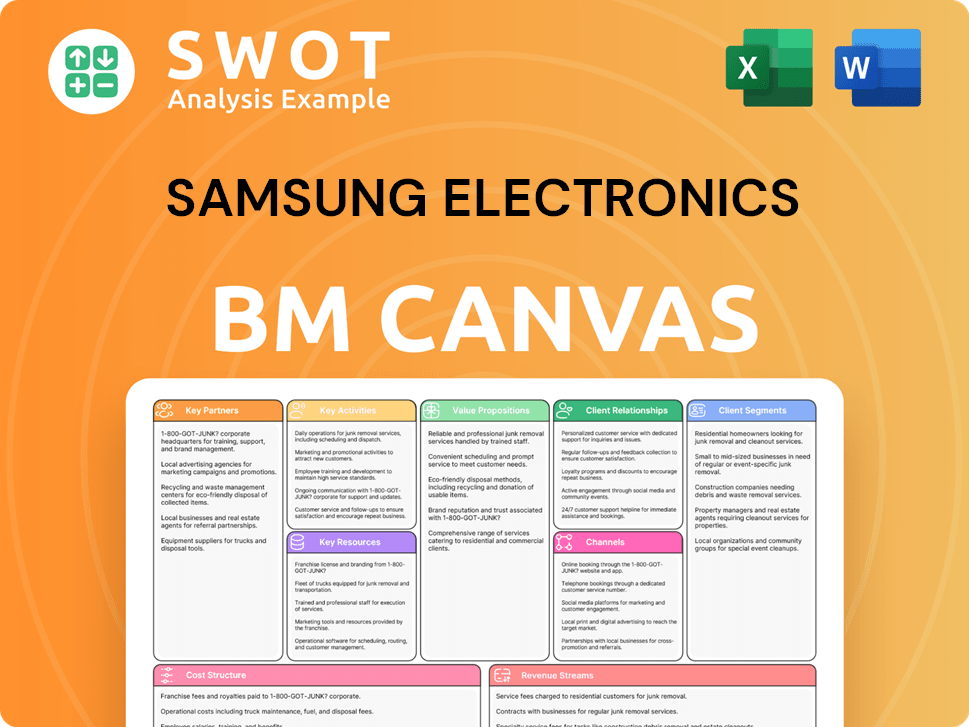
What Are Samsung Electronics’s Most Notable Campaigns?
The success of the company hinges on its robust sales and marketing strategies, which are crucial for maintaining its competitive edge in the electronics market. Central to this is a series of key campaigns designed to enhance brand visibility, drive sales, and foster customer loyalty. These initiatives are carefully crafted to resonate with diverse audiences and leverage the latest trends in digital marketing and consumer engagement. Understanding these campaigns provides insight into how the company positions itself within the competitive landscape, affecting its market share and overall performance.
A deep dive into the company's sales and marketing tactics reveals a sophisticated approach that blends traditional advertising with innovative digital strategies. From high-profile collaborations with global icons to user-generated content initiatives, the company continuously adapts its approach to capture consumer attention and build lasting relationships. These campaigns are not just about selling products; they are about creating experiences and building a community around the brand. This strategic focus is a key driver of its sustained success.
The company's marketing efforts are designed to support its extensive product portfolio, from smartphones to home appliances. Their sales performance analysis indicates that effective marketing directly correlates with increased sales and market share. The company's ability to adapt its strategies to changing consumer behaviors and market dynamics is a key factor in its ongoing success. For more information, Owners & Shareholders of Samsung Electronics can find detailed insights.
This campaign, which promotes the idea of pushing boundaries with technology, effectively positions products as tools for self-expression and innovation. The storytelling approach focuses on how products fit into and enhance people's daily lives, resonating across various cultures and demographics. This approach is designed to build a strong emotional connection with consumers, driving both brand loyalty and sales.
The #TeamGalaxy campaign actively encourages user-generated content, fostering community engagement on platforms like X/Twitter, Instagram, Facebook, and TikTok. This strategy increases brand visibility and creates a sense of belonging among users. By leveraging social media, the company builds a strong online presence and encourages organic reach, leading to increased brand awareness.
The collaboration with K-pop group BTS for the Galaxy S20 series was a strategic move that generated significant viral content. This campaign leveraged BTS's massive fan base across social media platforms. BTS-themed AR filters were used over 82 million times globally, demonstrating the impact of combining social media marketing with fandom engagement.
The 'Samsung Celebrates Big Ideas, Small Businesses' campaign, which won a Gold Winner award at the 2025 AVA Digital Awards, highlighted small and medium-sized businesses (SMBs) using the company's display technology. This integrated marketing campaign utilized a multifaceted approach including marketing strategy, social media and influencer marketing, content marketing, CRM, email marketing, web development, and public relations. It garnered over 1 million impressions and 30K engagements across social channels.
These campaigns demonstrate a commitment to creating engaging and targeted marketing initiatives that resonate with specific audiences and drive measurable results. Successful campaigns often include a blend of digital and traditional advertising. Effective use of social media, influencer partnerships, and user-generated content is crucial.
- Digital Engagement: Utilizing social media platforms like X/Twitter, Instagram, Facebook, and TikTok to foster community.
- Influencer Marketing: Partnering with tech influencers and lifestyle bloggers to build trust.
- User-Generated Content: Encouraging customers to create and share content.
- Strategic Partnerships: Collaborating with celebrities and other brands to expand reach.
- Integrated Marketing: Employing a multi-channel approach to maximize impact.
Samsung Electronics Porter's Five Forces Analysis
- Covers All 5 Competitive Forces in Detail
- Structured for Consultants, Students, and Founders
- 100% Editable in Microsoft Word & Excel
- Instant Digital Download – Use Immediately
- Compatible with Mac & PC – Fully Unlocked
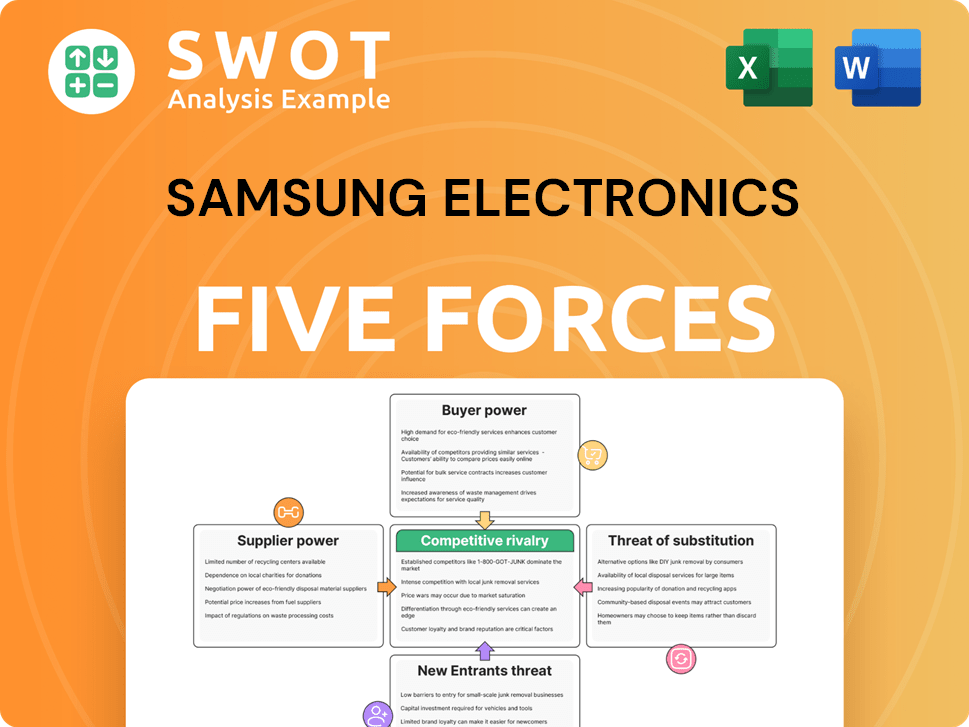
Related Blogs
- What are Mission Vision & Core Values of Samsung Electronics Company?
- What is Competitive Landscape of Samsung Electronics Company?
- What is Growth Strategy and Future Prospects of Samsung Electronics Company?
- How Does Samsung Electronics Company Work?
- What is Brief History of Samsung Electronics Company?
- Who Owns Samsung Electronics Company?
- What is Customer Demographics and Target Market of Samsung Electronics Company?
Disclaimer
All information, articles, and product details provided on this website are for general informational and educational purposes only. We do not claim any ownership over, nor do we intend to infringe upon, any trademarks, copyrights, logos, brand names, or other intellectual property mentioned or depicted on this site. Such intellectual property remains the property of its respective owners, and any references here are made solely for identification or informational purposes, without implying any affiliation, endorsement, or partnership.
We make no representations or warranties, express or implied, regarding the accuracy, completeness, or suitability of any content or products presented. Nothing on this website should be construed as legal, tax, investment, financial, medical, or other professional advice. In addition, no part of this site—including articles or product references—constitutes a solicitation, recommendation, endorsement, advertisement, or offer to buy or sell any securities, franchises, or other financial instruments, particularly in jurisdictions where such activity would be unlawful.
All content is of a general nature and may not address the specific circumstances of any individual or entity. It is not a substitute for professional advice or services. Any actions you take based on the information provided here are strictly at your own risk. You accept full responsibility for any decisions or outcomes arising from your use of this website and agree to release us from any liability in connection with your use of, or reliance upon, the content or products found herein.